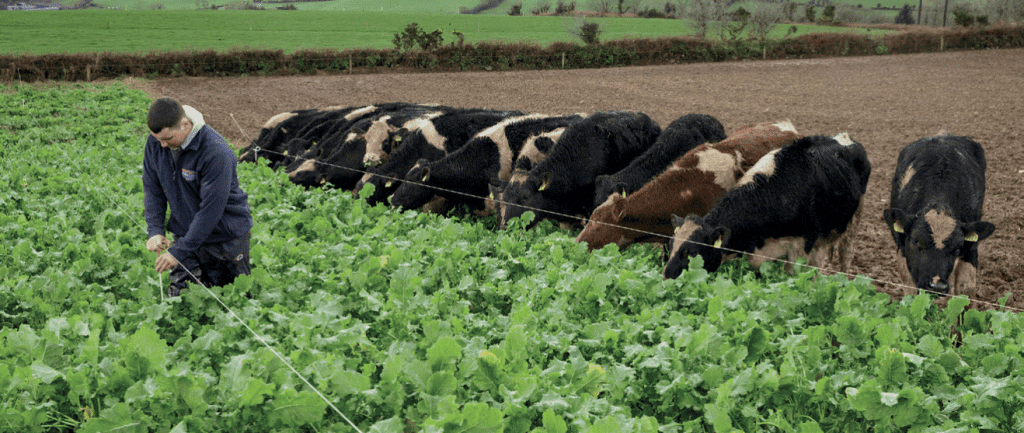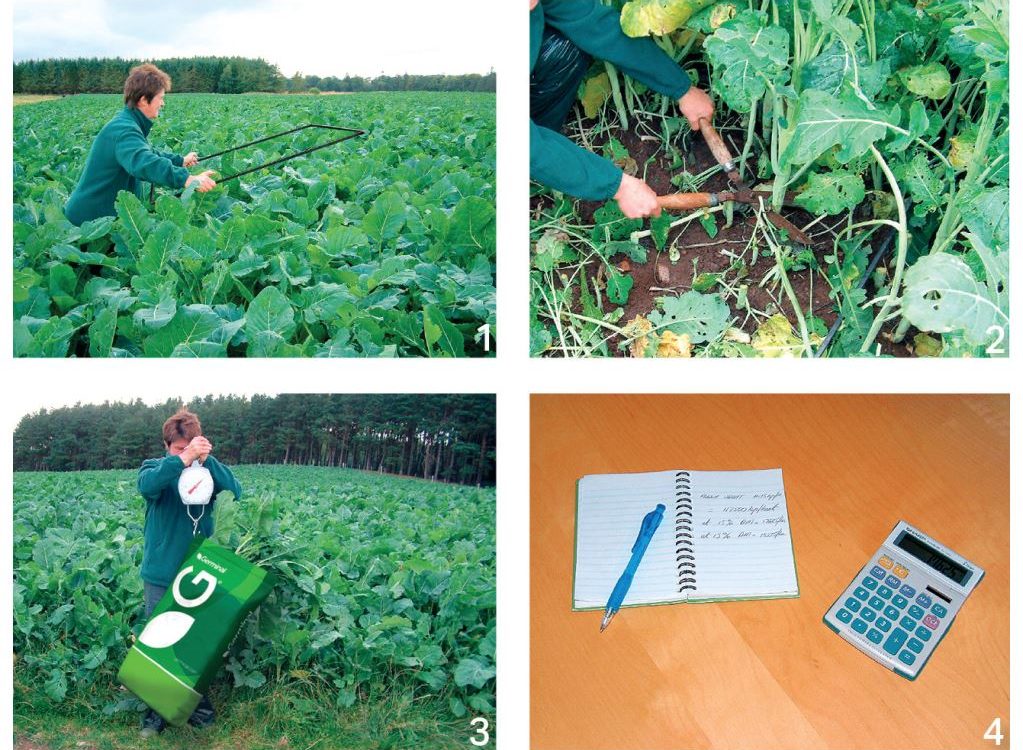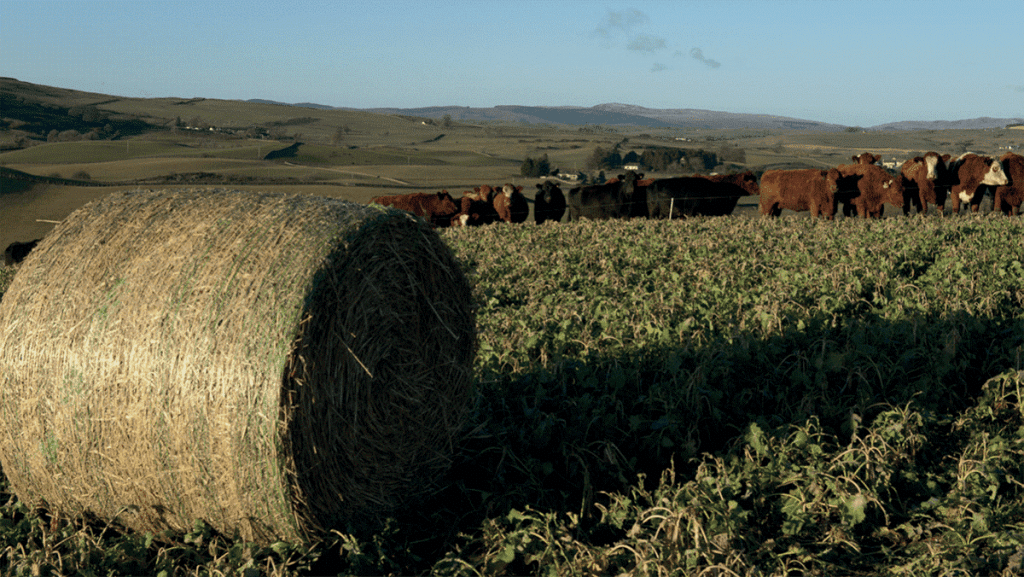There has been unprecedented use of forage brassicas in Ireland following years of extreme weather conditions.
Generally, these crops are most suited to grazing weanlings in-situ, but there are other options available that are discussed in this brassica guide.
The energy content of leafy brassicas is typically higher than that of grass and is similar to that of concentrate feeds. Brassicas have a high readily digestible carbohydrate content and are low in fibre, hence it is very important to provide a fibre source to ruminants to prevent rumen disorders.
Forage brassica composition
| Crop | DM% | Digestibility (D-value) | ME (MJ/kg DM) | CP (%) | Expected yield (t DM/ha)¹ |
| Kale | 14-16 | 80 | 10/11 | 16-18 | 10-12 |
| Hybrid brassica | 12-14 | 80 | 10/11 | 18-20 | 6-8 |
| Forage rape | 12-14 | 80 | 10/11 | 18-20 | 4-6 |
Grazing Management
- Introduce animals to brassicas slowly – increasing from 1-2 hours per day to full–time access after 10 days
- Brassicas are low in essential minerals – namely, iodine, selenium, copper and cobalt. Animals must be administered adequate minerals. We advise using a slow-release bolus. Speak to your vet for advice
- Brassicas should form no more than 70% of the diet – with 30% coming from a fibre source such as silage, straw or hay
- Always ensure constant access to fresh water
- Monitor animals regularly – Brassicas should be removed from the diet of pregnant animals 4–6 weeks prior to calving
Grazing in-situ
The most suitable option is to graze the brassica crops in-situ, where infrastructure allows. A good electric fence and easy access to water are two critical points to consider.
Despite mature brassicas having a low DM (approx. 12% DM), animals will still require constant access to fresh water. Not all animals will take to grazing brassicas, so it is important to watch animals carefully and, where necessary, remove any animal that is not grazing the brassica.
Out-wintered cattle will have a higher energy requirement compared to those housed indoors, requiring approximately 3% of their body weight to be allocated in daily dry matter intake.
For crops sown with the GLAS scheme, grazing of these crops is not permitted until after 1 December.
At this stage, the crop is sown and should be growing well. Brassicas should only be sown in free-draining soils with good pH (6.0–6.7) and where the soil is at P & K index 3. Steeply sloping sites should be avoided to reduce the risk of runoff.
Top tips for grazing brassicas
There are a number of points to consider before you begin grazing brassicas, such as kale, forage rape or hybrid brassica:
- Only healthy animals in good body condition score should be considered for out–wintering
- Do not out-winter in calf-heifers or thin cows
- Introduce stock slowly, on full stomachs – allow one to two hours access with runback to grass and build to full–time access after 10 days
- Do not turn hungry stock out to brassicas as they may gorge themselves and cause rumen disorders
- Brassicas should form no more than 70% of the diet, with 30% coming from a fibre source such as silage, hay or straw. Bales should be placed in the field around sowing, as this will simplify management when animals are grazing the crops (see Fig 02.)
- Always ensure constant access to fresh water
Bales placed in the field during dry weather reduce soil damage and workload in the winter when grazing the crops.
- Strip grazing will maximise utilisation and minimise wastage. Offer fresh feed to the animals at a similar time each day (twice daily in wet weather conditions)
- Graze the field in long narrow strips. This has multiple benefits
- All animals will have access to feed at the same time
- Reduces trampling of the crop and wastage of the feed
- Measure the yield of the crop to determine allocations and how much the fence should be moved each day (see How to measure the dry matter yield of your crop below)
- Measuring the yield of the crop allows you to monitor utilisation of the crop and estimate if feed allocations are correct
- If a lot of feed is ungrazed, it is likely animals are being overfed and the crop is being wasted
- If animals consume all feed and appear hungry you may be under allocating feed to your animals
- Very tall crops may earth your electric fence. To overcome this, some farmers travel through the crop on the fence line with a quad/light tractor, to knock the crop before putting the fence up
- A single strand of electric wire will be sufficient for cattle, allowing them to graze under the fence. A double-strand will be necessary for sheep
- Avoid feeding brassicas when the plant is frozen. If this is the case wait until midday when there is a thaw and offer the fresh break when plants are defrosted
- Have two fences up in front of animals – this way if they break ahead, they won’t trample a large proportion of the field (and animals will be easier to find!); and secondly, it is quicker (and safer) when leaving them into a fresh break
- On sloping fields, graze from the top of the field to the bottom, this will help reduce runoff
Cross-compliance
Brassica crops should not be grown on steeply sloping hills with a high soil erosion risk. Strip grazing from the top of the slope downwards can help reduce soil run-off.Watercourses and ditches alongside crops grazed through the winter are very susceptible to soil erosion, through poaching by livestock and destabilising of river banks. An uncultivated grass strip next to rivers, streams etc. and fencing these off will help reduce the risk of damage. |
Example of a field plan

Have two fences up in front of animals – this way if they break ahead, they won’t trample the whole field; and secondly, it is quicker and safer for you when you are offering them fresh break.

How to measure the dry matter yield of your crop
Equipment needed:
- A 1m square frame
- A large bag e.g fertiliser or seed bag
- A pair of garden shears
- Scales
A number of samples should be taken from each field, picking representative sampling points
- Place the frame in your forage crop
- Use the shears to cut each plant within the frame (about 10cm from the ground) and put the harvested crop in the bag
- Weigh the harvested crop and record the crop weight per m2
- Calculate the DM yield per hectare by multiplying the fresh weight per m2 by 10,000, then multiply by the expected crop DM percentage

Calculating daily feed allocation
| Example based on a 270 kg weanling requiring 8kg DM/day | Your livestock and fodder crop requirements | ||
| 1 | Livestock Total Intake (Estimate total daily intake on the basis of a dry matter requirement of 3% of liveweight) | 8 kg DM/day | |
| 2 | Brassica % of diet (How much of the diet will be grazed brassica?) | 70% | |
| 3 | Brassica Daily Requirement (Box 1 x Box 2) | 5.6 kg DM | |
| 4 | Number of Livestock | 25 | |
| 5 | Daily Requirement from Brassica (Box 3 x Box 4) | 140 kg DM | |
| 6 | Estimated Crop DM yield/m2* | 0.8 kg DM/m2 | |
| 7 | Total Daily Grazing Area Required (Box 5 / Box 6) | 175 m2 of brassica | |
| 8 | Length of Feed Face | 120 m | |
| 9 | Fence to be moved (Box 7 / Box 8) | 1.5 m/day |
*Based on crop yields of 10 t DM/ha, (1 kg/m2) x 80% utilisation. Grazing managment is important to optimise the potential of these crops. Strip grazing small areas will provide the most efficient utilisation. Grazing larger areas will increase trampling and waste of available forage.
Zero-grazing
There is some interest in zero-grazing brassicas, generally in situations where the crops were sown on tillage ground and there is limited fencing/access to water.
There are a number of points to bear in mind if zero-grazing forage brassicas, and this should be considered only in situations where in situ grazing is not an option.
- Take care to avoid soil contamination of the feed.
- Avoid excessive mechanical damage to the crop and do not chop. Disengage the conditioner on your mower.
- When introducing brassicas into the diet, do not offer to hungry animals as they may gorge themselves, and this may cause digestive upsets including bloat.
- Introduce brassicas slowly into the diet – increasing from 10% of the diet to no more than a maximum of 70% of the total diet (with the remaining 30% coming from silage, straw or hay).
- For milking cows, do not offer brassicas as more than 20% of the diet as it can cause milk taint.
- Brassicas are high energy crops and may not be suitable when cows are being dried off due to excess energy being provided in the diet.
- Speak to your animal nutritionist to ensure animals’ dietary requirements are being sufficiently met.
- Brassicas are low in essential minerals namely, iodine, selenium, copper and cobalt. Animals must be administered adequate minerals – speak to your vet for advice, as it may be influenced by the proportion of brassica in the diet.
- Due to the low DM% of the crop, brassicas can be prone to heating. Keep this in mind when determining the quantity of brassica being zero-grazed.
- Avoid feeding brassicas when the plant is frozen. If this is the case wait until midday when there is a thaw and zero-graze the crop then, so defrosted plants are offered to your animals.
Ensiling
By early October the opportunity for ensiling or baling hybrid brassicas has passed, and it should no longer be considered as a viable option. The low DM of the crop, combined with the limited opportunity to achieve a minimum two-day wilt, means ensiling these crops is no longer viable.
We have provided some advice for feeding brassicas which have been ensiled. Brassicas are low in DM (approx. 12%). This can result in saggy bales or a difficult to consolidate silage pit.
The following points assume that adequate preservation of the silage was achieved. Always ensure there are no issues with mould/heating when feeding the brassica silage to your stock.
- Remember it is a different feed to what your animals are accustomed to, so the rumen needs time to adjust. Introduce the brassica silage slowly.
- Brassicas will create a high-energy silage. It is best suited to animals who have a higher requirement (and less suitable to dry cows etc).
- Due to the difficulties ensiling brassicas, it is probably best to utilise them earlier in the winter, rather than wait until spring to feed the silage.
Baled brassicas

Animal health tips
If proper management has been followed animals grazing brassicas tend to do well over the winter, and once they are turned out to grass they thrive. In addition to best practices in terms of feeding and managing animals on brassica crops, there are some additional animal health tips that it is worthwhile to be aware of.
Most animal health problems are seen in the first few days of grazing the crops so watch animals particularly closely in the early days. Animals should always be checked at least twice a day when grazing brassicas.
Following the advice above will minimise the risk of a problem arising – do not introduce hungry animals to brassicas, introduce the crop slowly over a 10-day period.
Always provide a fibre source in the diet and ensure adequate minerals are provided to animals. Pregnant cows should be transitioned off brassicas approximately four to six weeks prior to calving.
It is unusual to see any of these health conditions once best practices are applied.
Acute Respiratory Distress Syndrome
Acute respiratory distress syndrome may develop when cattle are given sudden access to brassicas (more common in turnip fields) following relatively dry, high fibre diets.
Reduce the risk: Never introduce hungry animals onto brassicas. Introduce the brassica into the diet slowly over a period of 10 days or more and ensure the brassica comprises of no more than 70% of the diet.
Symptoms: Affected animals stand with extended heads, dilated nostrils and open mouths with protruding tongues. Death may occur quickly.
Treatment: Remove animals displaying symptoms immediately, increase fibre supplement to the remainder of the herd's diet and speak to your vet.
Hypothyroidism and Goitre
Brassicas contain glucosinolates, which block the uptake of iodine from the diet. In addition, the crops are low in iodine, thus increasing the risk of iodine deficiency. Pregnant animals grazing brassicas are most at risk and may give birth to hypothyroid offspring with a goitre, resulting in weak calves or stillbirths.
Reduce the risk: Due to the low mineral profile of brassicas, it is advised that all animals (pregnant or not) should be given a suitable iodine bolus. Speak to your vet to identify the most suitable product.
Milk taint
A section of the human population (determined by their genetics) can taste the bitter phenylthiocarbamide (PTC) chemical present in brassicas, therefore this should be taken into account by milk producers in particular (and others fattening animals on grass while also grazing brassicas).
Reduce the risk: Ensure brassica comprises of no more than 20% of the diet of milking cows.
Bloat
The introduction of a new feed always presents the risk of digestive/rumen upsets. A sudden change in the diet can cause bloat and death of the animal. Brassicas can be rapidly degraded in the rumen thus further increasing the risk of bloat.
Reduce the risk: As with any change in diet, it should occur slowly. Never introduce hungry animals onto brassicas.
Introduce the brassica into the diet slowly over a period of 10 days or more and ensure the brassica comprises no more than 70% of the diet, with 30% coming from a fibre source such as silage, hay or straw.
Symptoms: Easily recognisable to most and caused by a build-up of gas in the rumen, bloat is often first seen as swelling on the left abdomen and can cause death.
Treatment: Remove animals displaying symptoms immediately, increase fibre supplement to the remainder of the herd’s diet and speak to your vet.
Anaemia
Forage brassicas contain S-methylcysteine sulfoxide (SMCO). The SMCO is converted to dimethyl disulfide in the rumen. When absorbed into the bloodstream, this can cause anaemia.
Reduce the risk: Risk is greater when animals are on a pure brassica diet – remember brassicas should not form more than 70% of the diet, with the remaining 30% coming from a fibre source such as silage, hay or straw.
Introducing animals onto the brassica gradually over a period of 10 days or more will also help reduce the risk. SMCO content is higher in flowering crops.
Symptoms: Similar to redwater, the urine will be dark brown to red. The animal will not thrive and will have pale or yellow mucous membranes.
Treatment: Remove animals displaying symptoms immediately, increase fibre supplement to the remainder of the herd’s diet and speak to your vet.
Nitrates
Brassicas can be high in Nitrate-N, which can cause nitrate poisoning when nitrate is converted to nitrite in the rumen, particularly when young, leafy brassica crops are fed and the diets are also low in soluble carbohydrates.
Ensure crops have adequate time to utilise nitrogen. The plants will use approximately 2 units N per day. Redstart takes 90–100 days to reach maturity, forage rape takes approximately 110 days.
Reduce the risk: Never introduce hungry animals to brassicas. Introduce the brassica into the diet slowly over a period of 10 days or more and ensure the brassica comprises no more than 70% of the diet.
Symptoms: Clinical signs of nitrate poisoning include gasping and rapid respiration, a rapid heart rate, muscle tremors and weakness.
Treatment: Remove animals displaying symptoms immediately, increase fibre supplement to the remainder of the herd’s diet and speak to your vet.
Clostridial diseases
Clostridial diseases are predominantly caused by spores in the soil. Animals outdoors on any feed including grass and brassicas can contract them.
The organisms are highly infectious but not contagious. The spores may be ingested in feed or water.
Clostridial diseases can be vaccinated against relatively cheaply, and this is the best means of avoiding a problem. Speak to your vet for advice.
Ask an expert
Please contact one of our experts if you want advice on sowing brassica seed.
